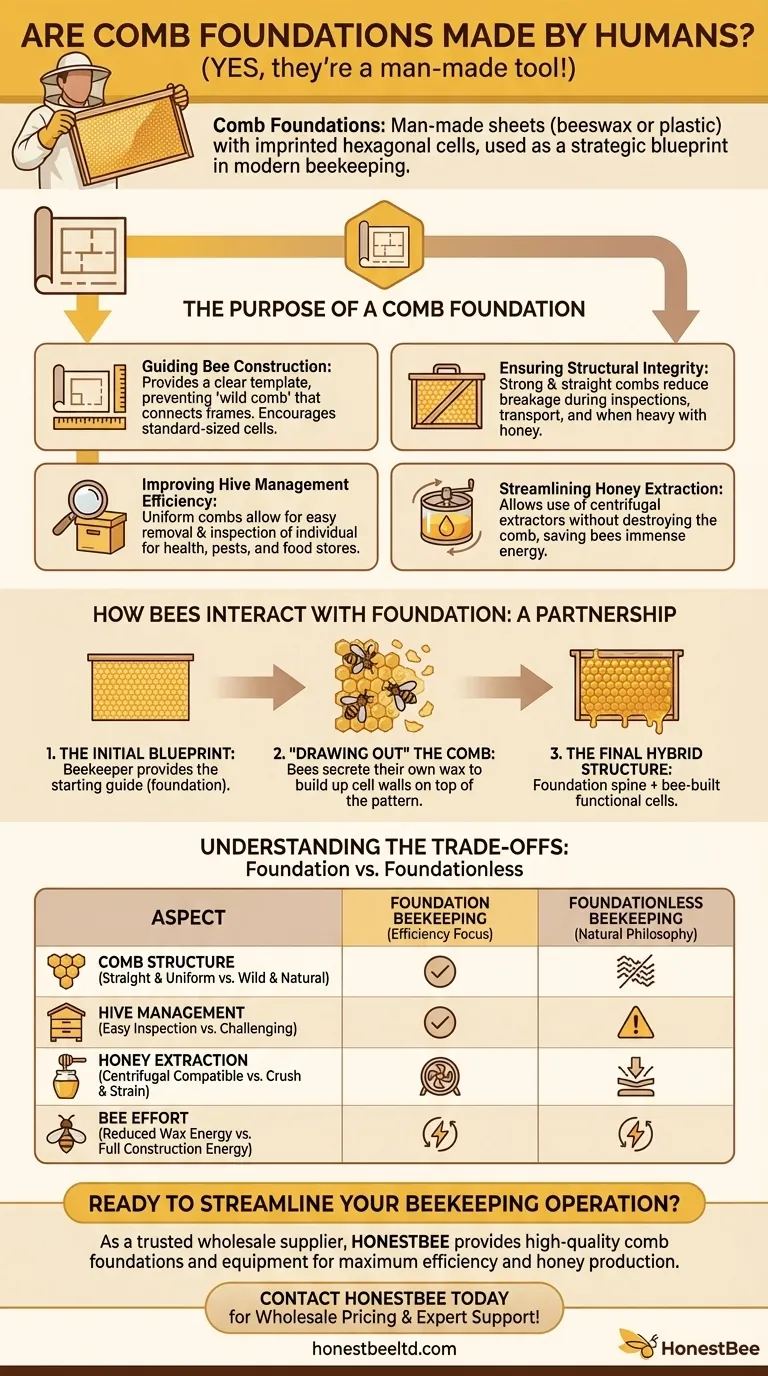Yes, comb foundations are a man-made tool used in modern beekeeping. They are thin sheets, typically made of beeswax or plastic imprinted with a honeycomb cell pattern, that are inserted into the wooden frames of a beehive. This provides the honeybees with a clear and stable guide for building their own wax comb.
While bees are the master architects of honeycomb, beekeepers use man-made comb foundations as a strategic blueprint. This tool guides the bees' construction, ensuring stronger, more uniform combs that make hive management and honey harvesting significantly more efficient.

The Purpose of a Comb Foundation
Using a foundation is a foundational practice in beekeeping because it provides a predictable structure that benefits both the bees and the beekeeper. It transforms a wild, natural process into a managed, agricultural one.
Guiding Bee Construction
A comb foundation provides a clear template. Without it, bees will build "wild comb" that may not align with the frame, often connecting multiple frames and making hive inspections nearly impossible without destroying their work.
The imprinted hexagonal pattern encourages bees to build the standard-sized cells needed for raising brood (young bees) and storing honey and pollen.
Ensuring Structural Integrity
Foundation-based combs are incredibly strong and straight. This structural integrity prevents the delicate wax comb from breaking, especially when it's heavy with honey or during inspections and transport.
Improving Hive Management Efficiency
Uniform combs that are neatly contained within their frames are essential for the beekeeper. They allow for the easy removal and inspection of individual frames to check the queen's health, look for pests, and assess food stores.
Streamlining Honey Extraction
Straight, even combs are critical for honey harvesting. They can be placed in a centrifugal extractor, which spins out the honey without destroying the comb. This allows the beekeeper to return the empty "drawn" comb to the bees, saving them the immense energy required to build new wax.
How Bees Interact with Foundation
The process is a partnership. The beekeeper provides the guide, and the bees perform the master construction work.
The Initial Blueprint
The foundation is simply a starting point. It does not replace the bees' own wax production.
"Drawing Out" the Comb
Once the foundation is in place, the bees begin to "draw it out." They consume nectar or honey and secrete their own beeswax from special glands. They use this new wax to build up the walls of the cells on top of the foundation pattern.
The Final Product: A Hybrid Structure
The finished comb is a hybrid of the man-made foundation and the bees' natural wax. The foundation serves as the central spine, while the functional cells are built entirely by the bees.
Understanding the Trade-offs
While using foundation is the industry standard, it's important to understand the alternative approach to appreciate its purpose fully.
The Argument for Foundation
Efficiency is the primary driver. Foundation ensures straight combs, speeds up the bees' building process, and makes management and extraction far simpler and less destructive. This is critical for commercial honey producers and most hobbyists.
The Argument for Foundationless Beekeeping
Some beekeepers prefer a more "natural" method and opt for foundationless beekeeping. They provide empty frames, sometimes with a small wooden guide strip, and allow the bees to build comb entirely on their own terms.
This approach requires more vigilant management to prevent cross-combing and can make honey extraction more difficult (often requiring a "crush and strain" method that destroys the comb). However, its proponents believe it allows bees to build their preferred cell sizes and live more naturally.
Making the Right Choice for Your Goal
Deciding whether to use foundation depends entirely on your beekeeping objectives.
- If your primary focus is maximizing honey production and ease of management: Using comb foundation is the standard, most efficient, and recommended method.
- If your primary focus is a more natural or "treatment-free" philosophy: You can explore foundationless beekeeping, but be prepared for the increased challenges in hive management.
Understanding this simple tool is the first step toward partnering with your bees effectively.
Summary Table:
| Aspect | Foundation Beekeeping | Foundationless Beekeeping |
|---|---|---|
| Comb Structure | Straight, uniform, frame-aligned | Wild, natural, can cross-comb |
| Hive Management | Easy inspection & frame removal | Challenging, risk of comb damage |
| Honey Extraction | Compatible with centrifugal extractors | Often requires crush & strain method |
| Bee Effort | Reduced wax building energy | Full natural wax construction |
Ready to streamline your beekeeping operation?
As a trusted wholesale supplier to commercial apiaries and beekeeping equipment distributors, HONESTBEE provides high-quality comb foundations and beekeeping equipment designed for maximum efficiency and honey production. Our products help you achieve stronger comb structures, easier hive management, and more effective honey harvesting.
Let's discuss how our beekeeping solutions can benefit your business:
Contact HONESTBEE today for wholesale pricing and expert support!
Visual Guide

Related Products
- Manual Beeswax Comb Foundation Machine Wax Foundation Mill Embossing Machine
- Notebook Style Beeswax Foundation Mould Wax Foundation Mold
- Beeswax Foundation Sheets Beehive Foundation for Wholesale
- Professional Frame Preparation: The HONESTBEE Electric Wire Embedder
- Food Grade Plastic bee Foundation for Bee Frames
People Also Ask
- What is the function of a beeswax foundation machine? Boost Hive Efficiency and Honey Production
- What is the importance of soaping the rollers during milling? Prevent Wax Adhesion & Equipment Downtime
- What is wax foundation made of? The Essential Guide to Pure Beeswax Foundations
- Why is it beneficial to make your own beeswax foundation? Gain Control Over Cost, Purity & Hive Health
- How should stuck wax on mill rollers be removed? A Gentle, Non-Damaging Cleaning Method



















